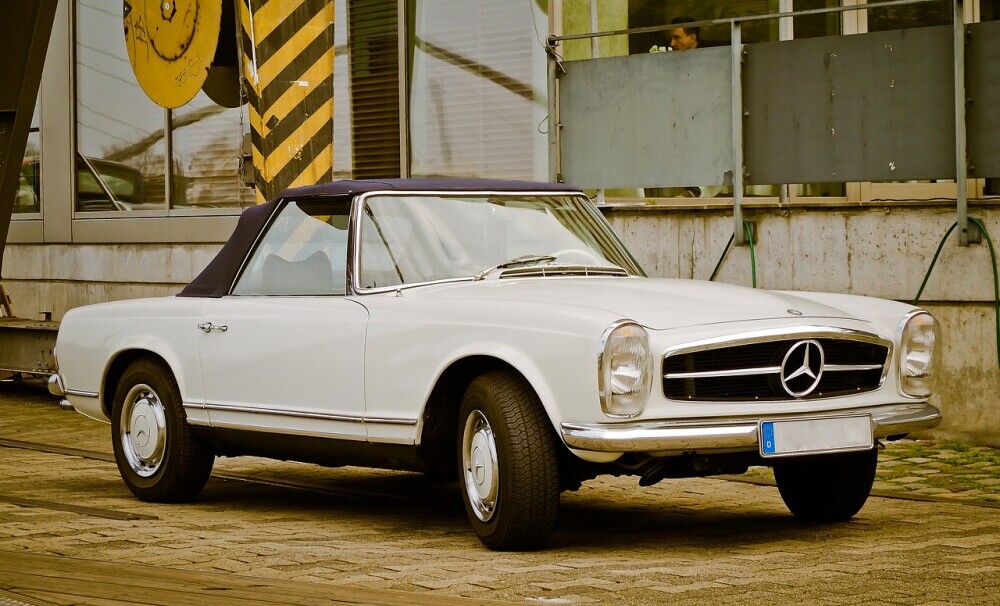
The 1965 Mercedes-Benz 230SL is an icon of classic automotive design, blending elegance, performance, and innovation. Known by enthusiasts as the “Pagoda” due to its distinctive concave roof, the 230SL set new standards for style and comfort in the 1960s, making it a highly desirable collector’s car today. Whether you’re a proud owner or a curious enthusiast, let’s take a closer look at what makes the 1965 Mercedes-Benz 230SL so special. Read my “Inside The Iconic 1965 Mercedes-Benz 230SL: 8 Fascinating Facts Every Enthusiast Should Know” article to find out more about this dream car.
The Mercedes-Benz 230SL wasn’t just about looks; it was a full package of luxury and innovation. It reflected the style of the 1960s but didn’t get lost in it. Its clean lines and balanced proportions showed off a refinement that turned heads without shouting for attention. Even today, it still stands as a strong symbol of sophistication.
Every element had a touch of the luxury vibe they were going for. The car embodied refinement and usability, making it a superstar in the Mercedes lineup back then. Today, it’s arguably one of those timeless beauties that enthusiasts and collectors drool over.
Many beloved celebrities fell for the 230SL’s charm, making it their ride of choice and further catapulting its status into legendary territory. Famous Hollywood actors and fashion moguls couldn’t resist its allure.
Art and fashion magazines of the era frequently featured the 230SL, showcasing it as more than just a car. It became an emblem of cool sophistication, bridging the gap between automotive engineering and aesthetic appeal.
This guide also includes resources for current or prospective owners looking to maintain, restore, or simply enjoy their 230SL to the fullest.
The 230SL’s Signature Style and Engineering
The 230SL was first introduced in 1963 as a replacement for the 190SL and 300SL models, offering a balance between performance and luxury. Designed by Paul Bracq and Béla Barényi, this car boasts clean lines, rounded headlights, and, of course, the distinctive “Pagoda” hardtop, which provides extra structural strength and better visibility. Under the hood, the 230SL came with a reliable 2.3-liter inline-six engine that was a masterpiece of its time, capable of producing 148 horsepower—a solid output for its time.
One of the most impressive advancements was the implementation of Bosch’s multi-port fuel injection system. This was a great innovation, improving fuel efficiency significantly and boosting overall performance. It’s like bringing tech magic into the automotive world, something that helped set the 230SL apart from its competitors.
Shifting gears, the 230SL came with choices. Drivers could opt for a four-speed manual transmission that gave them a more hands-on control, or go with the automatic transmission for a smoother glide. Both transmissions were well-engineered, giving drivers flexibility based on their personal driving style.
The 230SL was more than just another car – it represented a significant leap in engineering practices. It was designed not just for comfort on the road, but also for enhancing driving dynamics. Features like the fully independent suspension contributed to a ride that was as comfortable as it was responsive, a rare find in that era.
Resource:
- Mercedes-Benz Classic Center: For history, parts, and restoration advice, visit the Mercedes-Benz Classic Center
Fact 1: Understanding the 230SL Engine and Performance
The 1965 230SL is powered by the M127 engine, a 2.3-liter inline-six that offered smooth power delivery and dependable performance. This engine, combined with Bosch mechanical fuel injection, was quite advanced for its time, delivering 148 horsepower that allowed the car to cruise comfortably on highways or navigate city streets with ease.
Practical Tip: To maintain peak engine performance, ensure regular oil changes, valve adjustments, and fuel system inspections. These can prevent costly repairs, especially in classic engines where part wear can lead to performance issues.
Resources:
- Maintenance Guide: Hemmings offers articles on maintaining vintage Mercedes engines.
- Bosch Fuel Injection Parts: Bosch Auto Parts provides fuel system components compatible with the 230SL.
Fact 2: Embracing the Unique Driving Experience
Driving a 230SL is all about balance. While the car isn’t built for high-speed thrills, it shines with its comfortable ride and smooth handling, especially for a 1960s-era sports car. The 230SL is known for its stable, almost “sedan-like” handling and precise steering, making it a pleasure for Sunday drives or classic car rallies.
Practical Tip: Invest in high-quality tires that are appropriate for classic vehicles. Tires can greatly impact the car’s handling, and maintaining proper tire pressure is key to preserving the 230SL’s ride quality.
Resource:
- Classic Tire Options: Coker Tire offers vintage-style tires that enhance both performance and appearance for classic Mercedes models.
Fact 3: Maintaining the Iconic “Pagoda” Roof
The Pagoda roof is one of the 230SL’s standout features. With its concave shape, it provides increased rigidity, offering better protection for passengers in case of a rollover. While the roof is incredibly stylish, it requires special care to keep it in top condition. For soft tops, using quality fabric cleaners and water repellents will prevent mold and UV damage.
Practical Tip: If your car has the hardtop, inspect the rubber seals regularly to ensure no water leaks into the interior, as moisture can damage the upholstery.
Resources:
- Convertible Top Care: Raggtopp provides cleaners and protectants for convertible tops.
- Replacement Seals and Parts: SL Shop specializes in parts for classic Mercedes SL models, including roof seals.
Fact 4: Restoring and Preserving the Interior
The 230SL’s interior was designed for luxury, featuring leather seats, wood trim, and chrome accents. Restoring or maintaining the interior can be a rewarding project that brings out the car’s vintage charm. Original leather can often be revived with conditioning treatments, while wood and chrome can be polished to regain their shine.
Practical Tip: When restoring leather seats, avoid harsh cleaners, which can dry out and crack the leather. Instead, use a pH-neutral conditioner specifically designed for automotive leather.
Resources:
- Leather Restoration Kits: Leatherique provides restoration products that are ideal for classic car interiors.
- Wood and Chrome Care: Autogeek offers specialized products for wood and chrome preservation.
Fact 5: Sourcing Replacement Parts
Finding authentic parts for a 1965 230SL can be challenging, but it’s essential for preserving the car’s value and originality. Genuine Mercedes parts will ensure better fit, longevity, and performance. For rare parts, online forums, speciality shops, and even salvage yards are excellent resources.
Practical Tip: Keep a log of any part replacements or restorations you do. This documentation is valuable for resale and gives you a complete record of your car’s restoration journey.
Resources:
- OEM Mercedes Parts: Mercedes-Benz Classic Parts Search offers original parts for the 230SL.
- Vintage Parts Marketplace: BenzWorld is a Mercedes community where you can buy, sell, and trade parts with other enthusiasts.
Fact 6: Managing Routine Maintenance
Routine maintenance is crucial for keeping the 230SL running smoothly. Regular tasks include oil changes, coolant checks, brake inspections, and tire rotation. Given the age of the vehicle, it’s also wise to inspect the electrical system, as vintage wiring can deteriorate over time.
Practical Tip: If you’re not confident doing the maintenance yourself, seek a mechanic experienced with classic Mercedes models. They’ll understand the specifics of working with older cars and can prevent common issues before they happen.
Resources:
- Classic Car Maintenance Tips: YourMechanic offers advice on classic car maintenance and repairs.
- Mechanic Finder: Yelp can help locate classic car mechanics in your area.
Fact 7: Joining the Classic Mercedes Community
Owning a 1965 Mercedes-Benz 230SL means joining a community of enthusiasts who share a passion for these vintage cars. Connecting with other 230SL owners can provide you with restoration tips, part leads, and support for technical questions. Car shows, online forums, and Mercedes clubs are great ways to get involved.
Practical Tip: Attend local classic car shows or Mercedes-Benz Club of America events to meet fellow enthusiasts and learn more about caring for your 230SL.
Resources:
- Mercedes-Benz Club of America: MBCA hosts events and has an active forum for Mercedes owners.
- Classic Car Shows: Check Hemmings Events for a calendar of classic car events near you.
Fact 8: Increasing the Value of Your 230SL
With classic cars, maintaining originality often increases value. Restoring the 230SL with genuine Mercedes parts and keeping its original color scheme can improve its resale value. Documentation is also key; keep records of all repairs, maintenance, and restorations. This history makes the car more appealing to collectors who value transparency.
Practical Tip: Consider having your 230SL appraised by a classic car specialist if you’re planning to sell or insure it. They’ll help you understand its market value based on condition, originality, and demand.
Resources:
- Classic Car Appraisal: Dusty Cars offers appraisal services specifically for classic and collectible vehicles.
- Classic Car Valuation Tool: NADA Guides provides free estimates on classic car values.
Conclusion of the “Inside The Iconic 1965 Mercedes-Benz 230SL: 8 Fascinating Facts Every Enthusiast Should Know” Article
The 1965 Mercedes-Benz 230SL is a true classic that combines beauty, performance, and innovative engineering. For current and future owners, understanding the unique aspects of this car, from its “Pagoda” roof to its reliable M127 engine, makes owning and maintaining it all the more rewarding. By taking the time to care for and preserve your 230SL, you’re ensuring its legacy and charm for future generations.
With the resources and tips in this guide, you can enjoy your 230SL to the fullest, whether you’re embarking on a full restoration or simply keeping it in great condition.
